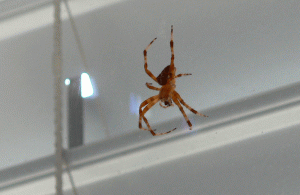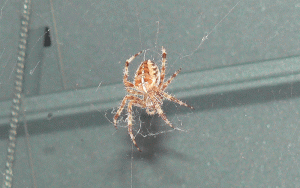I love it when Mother Nature steps forward to solve my problems. Until quite recently, a prominent grievance of mine were germ-taxies (houseflies). I’m locally famous for my knack at capturing them, which I suppose is fine. The thing is I’m keen on recycling and I felt bad for having little choice other than flush perfectly edible insects down the drain as I had no pet I could feed my prey to. That was, until Brunhilda came to my rescue.
The first time I saw her was when my darling lured me over to the bedroom by announcing he had something to show me and directed my gaze to the window above my side of the headboard. I was thrilled to see that while I was out, a newly-arrived friend had fitted it with a pure-silk, certified-organic flytrap that cut right through the airspace so cherished by insects. Brunhilda was sitting at the centre of her creation, looking a bit tense. I stood up on the headboard, inspected her up close, looked at my man and said, “Her butt looks flat, we need to fatten her up.” From then on, each captured fly has been presented to our new pal and she seemed to approve of this arrangement because Brunhilda, also known as Brunchy amongst her flatmates, is a diadem spider. And fatten her up we sure did.
Brunhilda on one of her early public appearances. Note her sad scrawny derrière. The little black ball she’s clutching in her fangs is what’s left of a fly we fed her.
And this is Brunhilda about a fortnight later. See what a curvy figure she cuts!
It wasn’t just that I wanted my spider to look more kardashianesque; by helping maintain a steady supply of food I hoped to make her stay by the window and intercept inbound insects rather than relocate somewhere where I might unwittingly step on her. But at the beginning, she would run and cower by the vent above the windowpane each time I ever so gently (by my standards, not necessarily hers) attached a fly to her web and would only come back to pounce on the offering after I had moved out of sight. As humans and spiders have been cohabiting since times immemorial, it saddens me to see that our long-standing symbiotic relationship is still marred by trust issues. I wish spiders could learn to control their anthropophobia (Greek for ‘fear of people’) by remembering these simple truths:
- Fearsome as their reputation may be, humans pose a relatively minor threat to you. Given that a typical spider shares its human flatmate with several dozen other spiders and of all the close encounters such a living arrangement surely produces, only a few evolve into an all-out confrontation. If you look at the arachnicide rates by perpetrator, you’ll see that the majority of fatal attacks against spiders are in fact committed by other spiders, which means you have way more reason to be wary when dealing with your own creed than fret about the occasional human you’re bound to bump into. Humans barely make it into the top 10 as they lag far behind spiders, birds, insects, lizards, frogs and whatnot in terms of confirmed spider kills. Only certain species of humans, perhaps most famously Australians, are known to regularly turn violent to spiders, usually right after realising their toenail has been pierced by the fangs of a boot-invading Atrax robustus, which is why a sensible spider will exercise extra caution when dealing with humans from down under.
- Being diurnal creatures, humans tend to be passive during the arachnid rush hour. Ever counted your blessings over the fact humans are up and about during daytime when you’re staying put and almost never lumber about in the night when you’re busy scurrying up and down the place? I’m sure many a spider has casually strolled over a human lying motionless in the dark and lived to tell about it. While primate-scaling arguably isn’t a sport for the faint-hearted arachnid, you should be just fine as long as you refrain from biting the sleeping human awake or crawling into its droolhole.
- The average human is more afraid of you than you are afraid of it. It may look and act scary but in fact it’s just frightened. Humans spook easily and you shouldn’t confuse their panic for a calculated act of aggression towards you. Do not try to intimidate or even attack an alarmed primate as it is liable to fight back and even resort to using chemical weapons. It’s much safer for both parties involved if you just walk away, lay low in your bolthole until the fuss is over and be more careful not to startle your human in the future.
- In fact, humans are your friends. The good ones regularly remove dust-gathering webs left behind by your long-gone colleagues, thus freeing up the best spots for you to showcase your web-spinning skills. But that’s nothing in comparison to the greatest favour they’re doing you: being messy eaters. They never seem to consume all their food; instead, they relegate a large portion of their slop to smelly bins that act as magnets to flies which you are quite happy to ensnare and suck dry. If it wasn’t for this peculiar human habit and the plethora of yummy bugs it entails, there would be much less of an incentive for you to shack up with humans.
Anyway, something animals, presumably spiders notwithstanding, can always be relied upon is their food-based logic. They figure that the hand that feeds you can’t be that bad, and I was hoping that, given some time, patience and a whole lot of juicy flies, Brunhilda would reach the same conclusion. Today, I am happy to say that Brunchy has taught me even more that I had taught her. Pictures are to follow.

